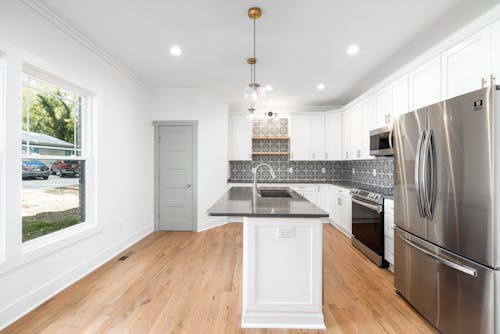Integrated lighting represents a revolution in the world of interior design, combining both contemporary aesthetics and technological innovation. By integrating light sources directly into architectural structures, this type of lighting not only transforms the appearance of spaces but also enhances their functionality. In this article, we will explore how integrated lighting can transform your spaces by merging modern design and cutting-edge technology.
1. What is Integrated Lighting? 💡🔍

Integrated lighting refers to lighting systems designed to be incorporated directly into architectural elements or furniture.Unlike traditional light fixtures, which are often surface-mounted, integrated lighting is discreet and often invisible, offering a harmonious light without cluttering the space.
-
Types of integrated lighting:
- Recessed LED strips: Used in ceilings, walls, or furniture to create uniform lighting.
- Recessed spotlights : Installed in ceilings or walls to provide targeted lighting without visible elements.
- Integrated linear fixtures: Located in niches or cornices for subtle indirect lighting.
Tip: Integrated lighting is ideal for modern spaces where a sleek design is desired. It can be used to highlight architectural features or artworks without compromising aesthetics.
2. Benefits of Integrated Lighting🌟🏠

Integrated lighting offers several significant benefits, both aesthetically and functionally:
- Sleek Aesthetics: By blending into surfaces, it achieves a smooth and integrated appearance, avoiding the need for bulky light fixtures or visible wires.
- Space Saving: Integrating light sources into existing structures optimizes space, which is particularly beneficial in small apartments or workspaces.
- Flexibility and Customization: Integrated lighting systems can be custom-designed to meet the specific needs of each room, allowing for maximum customization of lighting.
Tip: For an optimal lighting solution, consider integrating modular lighting zones that allow you to control the intensity and direction of light as needed.
3. Applications of Integrated Lighting in Various Spaces🏢✨
Integrated lighting can be adapted to different environments, each benefiting from its own characteristics:
- Kitchen: Integrated LED strips under cabinets provide functional lighting for countertops while maintaining a clean and modern design. Recessed spots in the ceiling provide clutter-free general lighting.
-
Living Room and Dining Room: Use linear fixtures integrated into cornices or ceilings to create a warm ambient lighting.Indirect lighting can also be used to highlight artworks or architectural elements.
Office: Integrating lighting into furniture or shelves creates a well-lit work environment while avoiding visual clutter.
Tip: Combine different types of integrated lighting to create distinct lighting zones suitable for various activities and moods.
4. Installation and Planning of Integrated Lighting
The installation of integrated lighting requires careful planning to ensure an optimal result.Here are some points to consider:
- Initial Design: Before installation, work with a designer or an architect to plan the placement of built-in fixtures and determine the best options for your space.
- Professional Installation: Hire a qualified electrician to install the integrated lighting systems, especially if structural modifications are necessary.
- Cable Management: Ensure that cables and connections are properly hidden to maintain the sleek appearance of integrated lighting.
Tip: Plan for cable drainage channels and connection boxes for a clean and organized final result.
5.Integrated Lighting and Durability Integrated lighting is often associated with ecological and energy-efficient practices, thus contributing to a more sustainable interior: Energy Saving: LED bulbs, commonly used in integrated lighting systems, consume less energy than traditional bulbs while offering a long lifespan. Sustainable Materials: Many integrated lighting systems are made from sustainable or recycled materials, thereby reducing their environmental impact.
Tip: Opt for integrated lighting systems that carry ecological certifications to ensure they meet strict environmental standards.
✨ Conclusion: Integrated Lighting, the Perfect Fusion of Design and Technology
Integrated lighting is much more than just a trend; it is an innovative solution that combines contemporary design and advanced technology to provide an exceptional lighting experience. By integrating light fixtures into architectural structures, you can create a space that is elegant, functional, and modern.
Are you ready to reinvent your space with integrated lighting? Explore our selection of integrated lighting solutions on our online store and discover how the fusion of design and technology can transform your interior.








